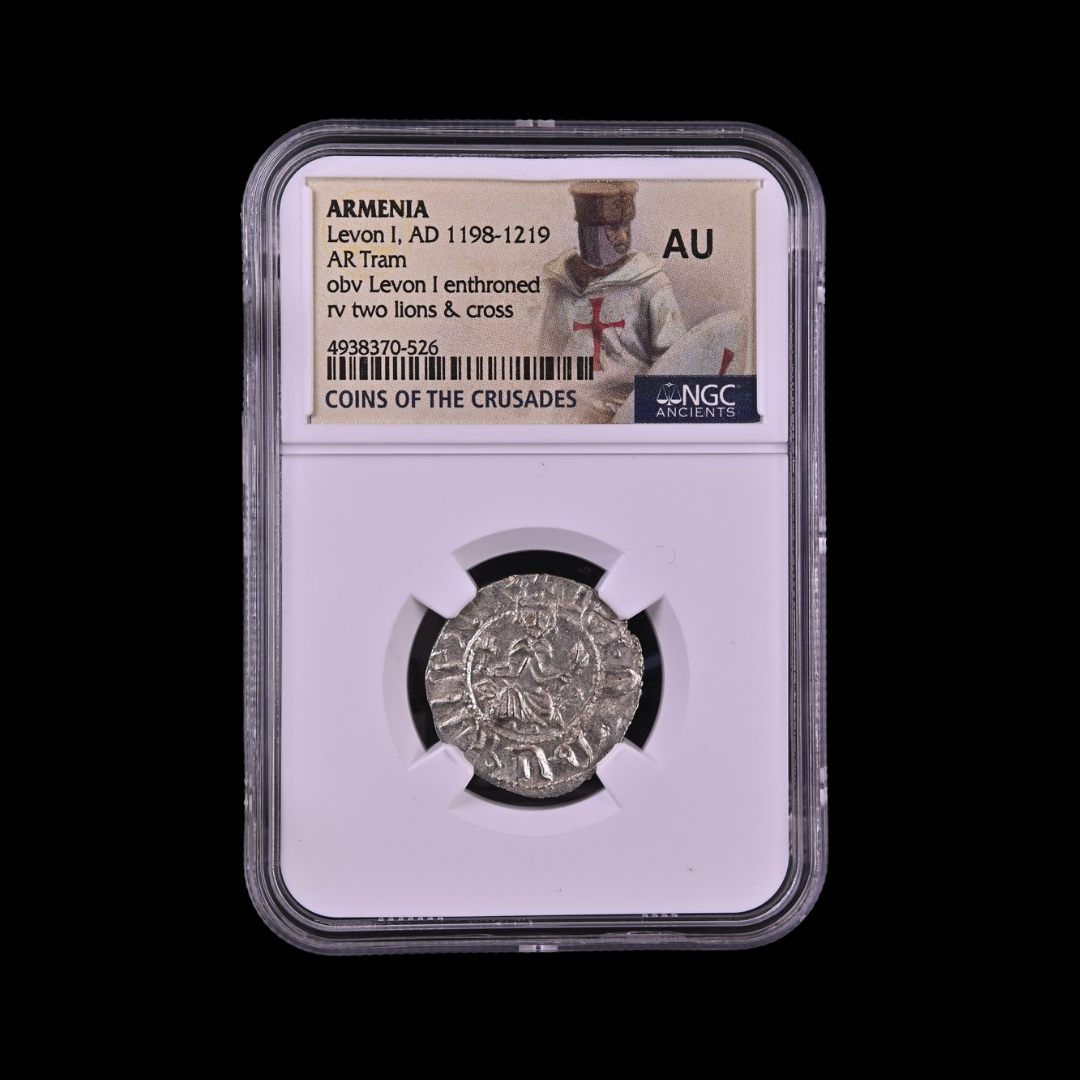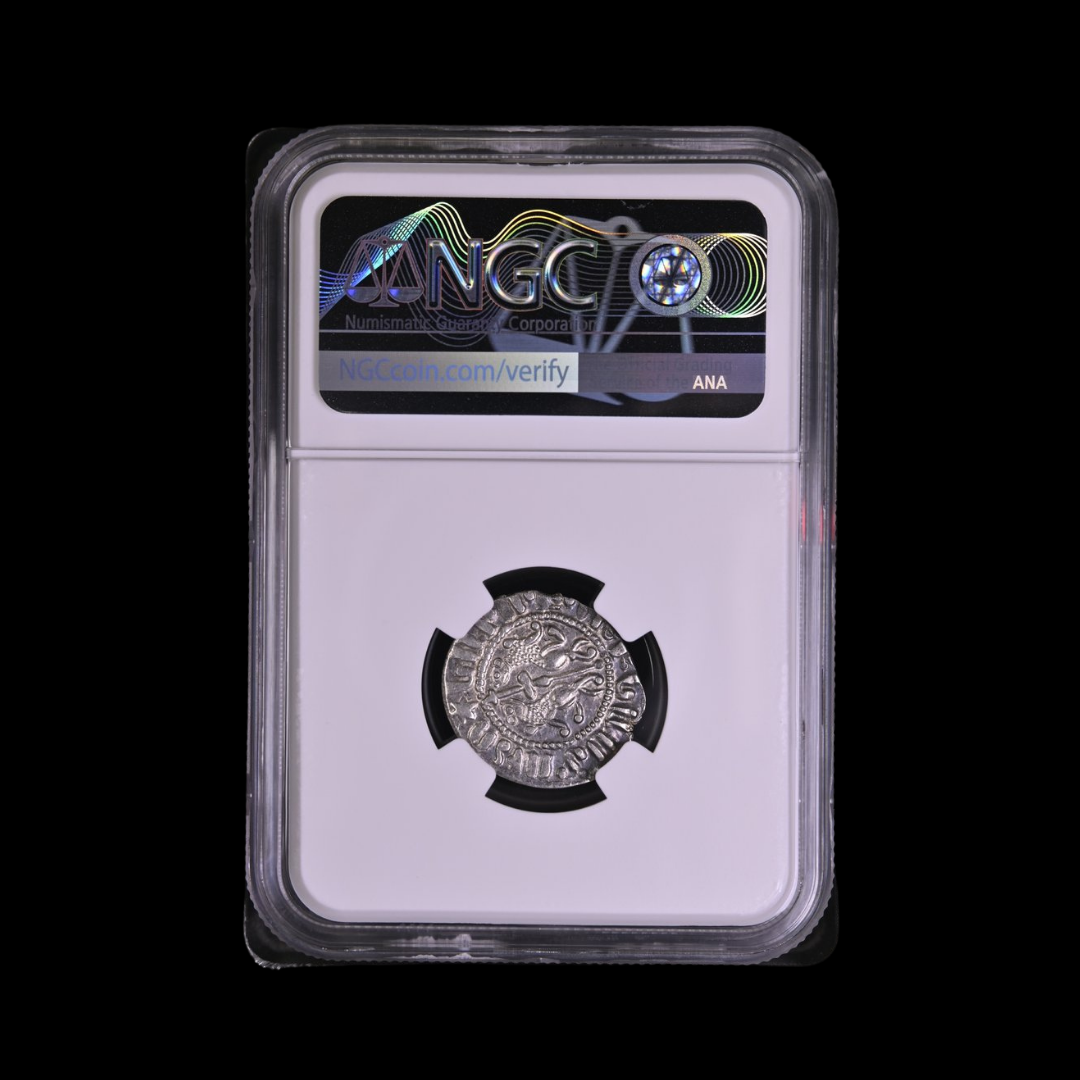 Image 1 of 2
Image 1 of 2

 Image 2 of 2
Image 2 of 2



Armenian Silver Tram of Levon I (about 800-825 years ago)
This is a silver tram from medieval Armenian Cilicia during the reign of King Levon I, a coin that circulated during a golden age of Armenian culture and commerce in the eastern Mediterranean region.
Coin Description:
Front side (Obverse): Features King Levon I seated on his royal throne
Back side (Reverse): Displays two heraldic lions and a Christian cross
Technical Details:
Silver composition (AR)
Tram denomination (main silver currency unit)
Certified by NGC with grade AU (About Uncirculated)
Minted during 1198-1219 CE
Historical Significance: Levon I's coronation as King of Armenian Cilicia in 1198 came after decades of Armenian diaspora following the Seljuk conquest of their traditional homeland. Under his leadership, the Armenian Kingdom of Cilicia became not only a haven for Armenian culture but also a significant economic power through its control of key Mediterranean trade routes and ports. These coins would have facilitated commerce throughout the region, from Crusader states to Byzantine territories and Muslim lands. The exceptionally high grade (AU) of these specimens suggests they may have been carefully preserved, possibly from a royal treasury or merchant cache, offering a direct connection to this fascinating chapter of Armenian history.
This is a silver tram from medieval Armenian Cilicia during the reign of King Levon I, a coin that circulated during a golden age of Armenian culture and commerce in the eastern Mediterranean region.
Coin Description:
Front side (Obverse): Features King Levon I seated on his royal throne
Back side (Reverse): Displays two heraldic lions and a Christian cross
Technical Details:
Silver composition (AR)
Tram denomination (main silver currency unit)
Certified by NGC with grade AU (About Uncirculated)
Minted during 1198-1219 CE
Historical Significance: Levon I's coronation as King of Armenian Cilicia in 1198 came after decades of Armenian diaspora following the Seljuk conquest of their traditional homeland. Under his leadership, the Armenian Kingdom of Cilicia became not only a haven for Armenian culture but also a significant economic power through its control of key Mediterranean trade routes and ports. These coins would have facilitated commerce throughout the region, from Crusader states to Byzantine territories and Muslim lands. The exceptionally high grade (AU) of these specimens suggests they may have been carefully preserved, possibly from a royal treasury or merchant cache, offering a direct connection to this fascinating chapter of Armenian history.
This is a silver tram from medieval Armenian Cilicia during the reign of King Levon I, a coin that circulated during a golden age of Armenian culture and commerce in the eastern Mediterranean region.
Coin Description:
Front side (Obverse): Features King Levon I seated on his royal throne
Back side (Reverse): Displays two heraldic lions and a Christian cross
Technical Details:
Silver composition (AR)
Tram denomination (main silver currency unit)
Certified by NGC with grade AU (About Uncirculated)
Minted during 1198-1219 CE
Historical Significance: Levon I's coronation as King of Armenian Cilicia in 1198 came after decades of Armenian diaspora following the Seljuk conquest of their traditional homeland. Under his leadership, the Armenian Kingdom of Cilicia became not only a haven for Armenian culture but also a significant economic power through its control of key Mediterranean trade routes and ports. These coins would have facilitated commerce throughout the region, from Crusader states to Byzantine territories and Muslim lands. The exceptionally high grade (AU) of these specimens suggests they may have been carefully preserved, possibly from a royal treasury or merchant cache, offering a direct connection to this fascinating chapter of Armenian history.
Leo II (Armenian: Լեւոն Ա Մեծագործ, romanized: Levon I. Metsagorts; 1150 – 2 May 1219)[a] was the tenth lord of Armenian Cilicia,[4] ruling from 1187 to 1219,[7]: [page needed] and the first king to be crowned, in 1198/9 (sometimes known as Levon I the Magnificent[4]).[b][4][7]: [page needed] Leo eagerly led his kingdom alongside the armies of the Third Crusade and provided the crusaders with provisions, guides, pack animals and all manner of aid.[3]
He was consecrated as king on 6 January 1198[7]: [page needed] or 1199.[4]
He was the younger son of Stephen, the third son of Leo I, lord of Armenian Cilicia.[7]: [page needed] His mother was Rita, a daughter of Sempad, Lord of Barbaron.[10] Leo's father, who was on his way to attend a banquet given by the Byzantine governor of Cilicia, Andronicus Euphorbenus,[4] was murdered[7]: [page needed] on 7 February 1165.[citation needed] Following their father's death, Leo and his elder brother Roupen lived with their uncle.[4][11]
You Might Also Like












